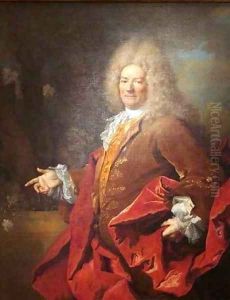Nicolas de Lagrillierre Paintings
Nicolas de Largillierre was a prominent French painter, born in Paris on October 10, 1656. His early life was marked by a move to Antwerp, where he was deeply influenced by the Flemish painting tradition. Largillierre's talent was evident from a young age, leading him to apprentice with the renowned painter Antoine Goubeau in France before moving on to work under the guidance of the Flemish master, Peter Paul Rubens. This period was crucial in shaping his style, imbuing it with a mix of French elegance and Flemish richness in color and texture.
After his time in Antwerp, Largillierre traveled to England in 1674, where he worked for the Duke of Monmouth and other prominent figures. His English period contributed to his development as a portraitist, blending realism with a sense of grandeur. However, his stay in England was short-lived due to political unrest, and he returned to Paris in 1676. In Paris, Largillierre quickly established himself as a leading portrait painter, gaining membership in the prestigious Royal Academy of Painting and Sculpture in 1686. His work was characterized by a vibrant use of color and a masterful rendering of textures, which made his portraits highly sought after by the French aristocracy and bourgeoisie alike.
Largillierre's contribution to art was not limited to portraiture. He also excelled in still life and religious painting, showing a remarkable versatility. His still lifes, in particular, are noted for their vivid realism and intricate detail, reflecting the influence of Dutch and Flemish masters. Throughout his career, Largillierre showed a keen interest in the natural world, which is evident in the lush backgrounds of his portraits and the meticulousness of his still lifes.
By the time of his death on March 20, 1746, Nicolas de Largillierre had become one of the most celebrated painters of his generation. His legacy is preserved in many of the world's leading museums, where his portraits continue to be admired for their richness and depth. Largillierre's work represents a bridge between the classical Baroque style and the emerging Rococo movement, capturing the transition in European art from the grandeur of the 17th century to the elegance and lightness of the 18th century.
